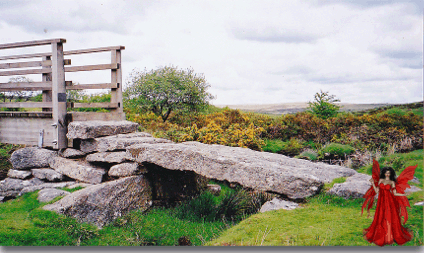
In October 2014 the Dartmoor National Park Authority announced that due to the severe storms of February that year Swincombe Bridge was badly damaged and following an inspection in the summer was deemed unsafe and so was closed. Further inspections showed that the damage had worsened and so the bridge was condemned and removed. This did however leave the stepping stones which could be used to cross the river provided the water level was not too high. This location has always been a preferred crossing point of the river Swincombe, indeed the route of the medieval Tavistock to Ashburton Packhorse Track once ran through there when it was simply a ford.
In later years miners from Mary Tavy would use the crossing point to get to the Hensroost and Hooten Wheals mines. As always this task always depended on the water levels as to how easy this would be and so in order to ensure a safe passage a wooden clam bridge was constructed in 1892, Stanbrook, p.57. This is further substantiated by William Crossing when he notes: “From Princetown the Mary Tavy men followed the route across Tor Royal newtake to Swincombe, where there is a ford over the stream of that name, and also stepping stones. But during a heavy flood it was not possible to cross by means of the latter, and a wooden footbridge was therefore erected,” The Dartmoor Worker, p.66. At this point in time the bridge was simply known as ‘Swincombe Clam’ and was a godsend to the miners and residents of the various nearby cotts who regularly needed to cross the river. Also it seems the bridge was used by the local hunt for Hemery tells of Elizabeth Coaker’s encounter with a pack of hounds found attacking a ewe which she managed to drive off with a stout stick, p.366.
There is a slight quandary here, as seen above the footbridge was erected in 1892 and even today there is evidence of the presence of a one-time clapper bridge as can be seen below. However, none of the early topographical writers give any mention of such as far as I can find?

But a few years later it took on a more fanciful name – Fairy Bridge. The earliest mention of this name that I can find appears in William Crossing‘s book the ‘Guide to Dartmoor’ written around the early 1900s. He, without any explanation he says: “A little further on we shall desert the track, which runs down to Swincombe Ford and the Fairy Bridge…,” p.464. There has always been an ancient belief in water deities on Dartmoor a such as the example of the River Dart whose deity is said to claim a life every year. Could it be that somebody at some point considered that such a deity of the river Swincombe dwelt here and provided protection for those crossing the waters? There can be no question that in much later years somebody decided that Fairy Bridge should have a representation of its deity. For sometime in the early 2000s a small figure of a fairy appeared under the bridge. For a good eight years she peacefully sat under the bridge providing protection for those crossing the river. Then in 2008 she got damaged, whether as a result of trying to withstand the Dartmoor weather and the river Swincombe’s angry spates or at the hand of a human nobody knows. Luckily the following year a replacement was found and installed under the bridge, once again keeping a watch on all moorland travellers. Sadly she also suffered the same fate as her previous guardian and so yet another fairy was found and installed but once again she too did not last long.
Anyway, enough of being away with the fairies for now, back to the bridge itself which tells the same story of the farmer with his hay fork. He said it has lasted him for years and years and over that time had only three replacement forks and six handles. The same with Swincombe clam, in 1972 a new bridge was erected at the site which utilised what probably was the original abutments. This version was constructed from telegraph poles, planks and a wire handrail. Sometime shortly after being built Eric Hemery commented that; “Fairy Bridge trembles unnervingly when trodden by several persons simultaneously,” p.117. No matter how rickety this bridge was it did in one form or another manage to last until 1995 when its more sturdy replacement was installed. This version commemorated the 30th anniversary of the Dartmoor Expedition Panel, associated of the Duke of Edinburgh’s Award Scheme. To mark this fact a plaque stating: “SWINCOMBE BRIDGE WAS REPLACED – ON 23rd OF AUGUST 1995 – TO COMMEMORATE THE – 30th ANNIVERSARY OF THE – DARTMOOR EXPEDITION PANEL – 1965 – 1995.” was placed on a post at the end of the bridge.

We then come up-to-date with the 1995 bridge being removed and eagerly await the opening of the 2015 version which should be sometime in the Spring. There is some uncertainty as to what has been missed the most, ; the actual bridge or its guardian fairy? Hopefully when the new bridge is in-situ both the fairy and the 1995 commemorative plaque will return to once again grace the bridge which over the years has seen many a thankful footfall. The new bridge was finally finished and ready for active service in the June of 2015.

Crossing, W. 1966. Crossing’s Dartmoor Worker. Newton Abbot: David & Charles Ltd.
Crossing, W. 1990 Crossing’s Guide to Dartmoor. Exeter: Newton Abbot: Peninsula Press.
Hemery, E. 1983. High Dartmoor. London: Robert Hale Publishing.
Hemery, E. 1986. Walking Dartmoor’s Ancient Tracks. London: Robert Hale.
Stanbrook, E. 1994. Dartmoor Forest Farms. Tiverton: Devon Books.
 Legendary Dartmoor The many aspects past and present of Dartmoor
Legendary Dartmoor The many aspects past and present of Dartmoor

The fairy has returned and is sitting under the bridge. She was seen on.Wednesday.